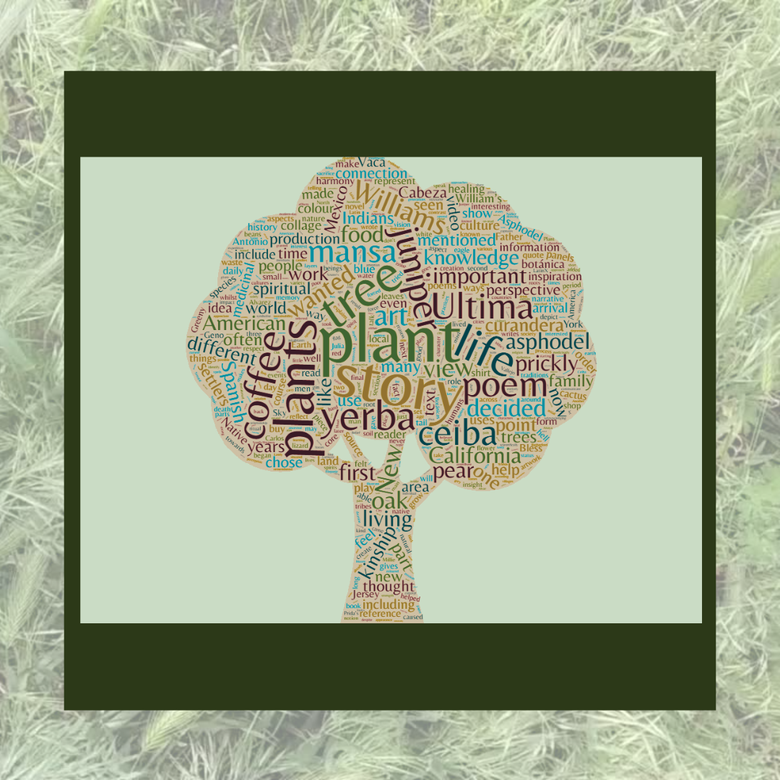Intra-active TeXts

Prickly Pear
by Savannah Pearce
I wanted to continue the theme of the prickly pear that aided in the escape of Álvar Núñez Cabeza de Vaca. According to Eliseo Torres, Cabeza de Vaca may even be “one of the first curanderos[1] […] in the American Southwest and Mexico” (cited in Galante 2001: 10). This is reflected in my project as my representation of Cabeza de Vaca displays his knowledge of the prickly pear by telling his companions of the ways in which it may be used medicinally. In Aztec tradition, the prickly pear plays a vital role in the founding of Tenochtitlan, now Mexico City. Interestingly, Mexico is where Cabeza de Vaca finished his expedition through South-Western North America. I have used recycled magazines, paper, and sand from my local beach so that I did not have to buy any new products that might contribute to deforestation.
Oak Tree
by Sheena Stewart
The article "Ranch and Mission Days in Alta California" by Guadalupe Vallejo, was my choice for my project. Colonisation, immigration, and the movement of large populations have a profound effect on existing environments and cultures. The triptych illustrates visually the changes that happened in this single area of Alta California. However, changes like this have happened throughout the world, eliminating cultures, and losing important plant species as well as local knowledge. We are slowly becoming aware of the detrimental effects of extensive farming, monocultures, and loss of language and culture, and increasingly we are acknowledging the positive effects and benefits of diversity. I tried to use this opportunity to emphasise the importance of being aware of all the elements of our environment, plants, animals, and humans, in order to have a balanced approach to our environment that will help to sustain life on the planet.
Asphodel
by Chloé Broadley
William Carlos Williams (1986: 310-11) writes, “I added pressed flowers until, after a time, I had a good collection. The asphodel, forebodingly, among them. I bring you, reawakened, a memory of those flowers.” I took inspiration from this quote and I imagined what it would be like for the flower to be pressed in a book. Williams daily interactions with plant life provided him with the knowledge of different plants that he later used to write his poems. I decided to solely add colour to the leaves of the plant in order to emphasise the poem’s title “Asphodel, That Greeny Flower” and to keep the rest of the plant colourless in reference to a part in the poem where he describes it as a “colorless thing.”
Juniper
by Jo McQueen
I decided to make a collage for my art project because it is an efficient way to bind together different realms, stories or concepts to produce a new and unique creation (Vaughan 2005: 41). My project is inspired by Rudolfo Anaya’s 1972 novel Bless me, Ultima a coming-of-age story set in 1940s New Mexico about a young boy Antonio, who is deciding his future path whilst exploring his connection to the land with the help of a curandera named Ultima. I wrote my story with a rhythmic pattern because I wanted to illustrate the ancestral tradition of passing on remembered information orally such as herbal remedies. As I wrote the rhyming poem, I began to personally reflect on kinship more thoroughly as it was not a belief that I had previously considered.
Yerba Mansa
by Louisa Cousland
Curanderas show their respect to the plants and have a spiritual connection with them. This highlights the importance of the notion of kinship across species and emphasises harmony between people and nature. My fictional story, as with my artwork, is situated next to the Guadalupe River in a hot climate but in damp conditions. I specified that it was March because that is when yerba mansas begin to bloom. I decided that my plant would change their perspective, at first saddened and unhappy with the prospect that their life will be taken away, and then after realising they have magical healing abilities and noticing how important they are to the abuela curandera and Miguel. I wanted to show my plants thought process and the change in perspective, at first unhappy to die and then to willingly sacrifice their life.
Ceiba
by Callum Hathaway
The play “Botánica” makes reference to the floods (el diluvio universal). In this Yoruban myth, in which the god Obá-Olorún sends a powerful flood to the earth as a punishment, the ceiba is the only plant to survive it, protecting everything underneath it from the water. This story adds to the representation of the ceiba as a protector and a powerful spiritual force. In order to show this in my art project, I decided to depict the ceiba tree during these floods, and I also added a “liquify” design effect, to show a theme of water running through my painting. [...] Within my story I wanted to convey the hard fight that Latinx businesses, like the botánica, are facing every day just to stay open. I also wanted to show the hope that symbols such as the ceiba can convey to these communities.
Aloe vera
by Lou Parra
Something that appeals to me about Dolores Prida’s play “Botánica” is that her main character, the grandmother Dona Geño, knows her plants. It is precisely why the first remedy that she provides to one of her clients is related to one of the most common and widely used plants around the world since the 16th Century BC. As the hours pass, the aloe vera reflects on her/his life course in terms of episodes through the years and aims for a better and longer life. Each slide/hour represents what could be inside the aloe’s memory. The symbolic objects are sparking and with movement because they represent meaningful moments, and the background is black because it goes to the unknown world of the plant. It is within the darkness that we can sense things differently.
Coffee
by Klára Vítková
One design captures the shirt with a red underlayer which is to represent the blood spilt by small farmers whose hard work gets lost in the vortex of mass production. Also, it attempts to challenge the idea of the innocence of coffee consumers who are unaware of what hides under their daily espresso. To contrast this hardship, I decided to mimic the dichotomy of my story by bringing in a side-by-side comparison of this garment with a differently coloured layer underneath. The colour blue was implemented to signify freedom and peace of the shade-grown coffee shrubs. The core message of A Cafecito Story resonates with the world even more so now and it must not be limited solely to the harvesting of coffee beans. My project seeks to build on Julia Alvarez’s story and extend its mission to a new audience so that we make educated decisions in our daily lives.
[1] Mexican/Mexican-American folk healer.
Instagram link
Cited texts
Alvarez, Julia (2002). A Cafecito Story: El cuento del cafecito. White River Junction, Vt: Chelsea Green Pub. Co.
Anaya, Rudolfo (1994 [1972]). Bless me, Ultima. New York: Grand Central Publishing.
Anzaldúa, Gloria (2015). Light in the Dark/Luz en lo oscuro: Rewriting Identity, Spirituality, Reality. Durham, NC: Duke University Press.
Barad, Karen. (2007). Meeting the Universe Halfway: Quantum Physics and the Entanglement of Matter and Meaning. Durham: Duke University Press.
Galante, Paul (2001), “Cabeza de Vaca: The Rider on the Psychic Borderlands in Nicolas Echevarria’s Cabeza de Vaca.” MA Lehigh University Theses and Dissertations. <https://core.ac.uk/download/pdf/228644528.pdf> [accessed 29 March 2021].
Haraway, Donna (2016). Staying With the Trouble: Making Kin in the Chthulucene. Durham, NC: Duke University Press.
Hartman, Joseph (2011). “The Ceiba Tree as a Multivocal Signifier. Afro-cuban Symbolism, Political Performance, and Urban Space in the Cuban Republic.” Hemisphere: Visual Cultures of the Americas 4, 1, pp. 16-41.
Núñez Cabeza de Vaca, Álvar (2002 [1542]), Chronicle of the Narváez Expedition. Bandelier, Fanny (tr.). Penguin: London.
Prida, Dolores (2000). “Botánica.” In Puro Teatro: A Latina Anthology. Sandoval-Sánchez, Alberto and Nancy Saporta Sternbach (eds.). Tucson: The University of Arizona Press, pp. 7-45.
Vallejo, Guadalupe (1890). “Ranch and Mission Days in Alta California.” Century Illustrated Monthly Magazine XLI:2, pp. 183–92.
Vaughan, Kathleen (2005). “Pieced Together: Collage as an Artist’s Method for Interdisciplinary Research.” International Journal of Qualitative Methods 4.1, pp. 27-52.
Williams, William Carlos (1986). The Collected Poems of William Carlos Williams. New York: New Directions.
 |
